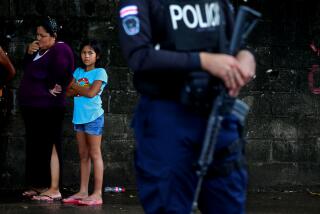Radar Sharing in Drug War Is Questioned
- Share via
CORPUS CHRISTI, Tex. — The radar detects a plane hauling coca leaf over the Peruvian jungle. The technology runs cleanly, precisely. That’s not what bothers some federal employees. It’s what happens next.
Using radar data from the U.S. Customs Service and the U.S. Air Force, the Colombian and Peruvian fighters are intercepting and, in some cases, shooting down airborne drug smugglers.
At least 27 flights have been forced to land, seized, destroyed on the ground, or shot out of the sky since the Air Force resumed its radar-sharing program in March, said Lt. Col. Byron Conover, spokesman for the U.S. Southern Command in Panama.
Pentagon officials say Operation Constant Vigil makes it harder for Colombian drug chiefs to airlift raw coca from Peru to cocaine processing labs in Colombia. Peru is the source of at least 60% of the world’s coca leaf.
Supporters say disrupting air routes pressures the Cali cocaine cartel, which has seen six of its top leaders fall into the hands of Colombian police since June.
But some Customs agents believe the operation strays beyond their duty to enforce smuggling laws and arrest offenders.
“I don’t think we should be doing it,” radar operator John Fowler said. “I’m a Christian man. I am a believer. How can I as a believer work toward an end which deals with killing people?”
The air surveillance involves secret ground radar stations in South America and two kinds of radar-equipped planes based in Peru.
Customs began air surveillance in the 1970s to detect contraband flights into U.S. airspace. It was the George Bush Administration that pushed the idea of sharing radar intelligence with the Andean air forces, contending that interdiction must start at the source of the multibillion-dollar coca industry.
“One of the critical vulnerabilities of the traffickers is the reliance on general aviation or small aircraft to fly the loads of coca base from Bolivia and Peru to Colombia,” said Brian Sheridan, a top Defense Department official for drug issues.
The United States suspended radar sharing in May, 1994, out of concern that U.S. officials could be held liable if Colombia or Peru shot down the wrong plane.
President Clinton gave a fresh go-ahead in December, signing executive determinations that the two Andean air forces have adequate safeguards to prevent accidental shoot-downs.
The host nation cannot use U.S. data to attack a plane unless it is flying without a flight plan in a no-fly zone, said Conover of the Southern Command.
The rules of engagement say Peruvian and Colombian fighters must try to make radio contact and visually signal a suspect aircraft to land for inspection before opening fire. If the pilot balks, warning shots must be fired before a high-ranking air force officer of Peru or Colombia can give a “kill order.”
“They don’t simply fly up to it and shoot it down,” said a Pentagon official who supports the program. “We think it is a rigorous process, and drug traffickers go into these areas at their own peril.”
Others are less certain. Critics cite two midair interventions with tragic consequences.
On April 14, 1994, a pair of U.S. fighter jets enforcing the no-fly zone over northern Iraq shot down two U.S. Army helicopters they had mistaken for Iraqi craft. All 26 people aboard were killed. An investigation found that a radar plane failed to warn the fighters of the choppers’ identity.
On July 3, 1988, the USS Vincennes shot down an Air Iran plane carrying 290 people. The Vincennes believed the airliner was an attacking fighter jet.
“We cannot take the chance of having such a tragedy repeated in the tension-loaded Andean drug-smuggling environment,” said J. Randolph Babbitt, president of the Air Line Pilots Assn., in opposing the plan in Congress last year. Babbitt’s organization represents 42,000 civilian pilots.
“Our members and their passengers would be at risk.”
A radar operator who spoke anonymously had another concern: “Probable cause doesn’t warrant the death penalty. Mistakes can happen.”
More to Read
Sign up for Essential California
The most important California stories and recommendations in your inbox every morning.
You may occasionally receive promotional content from the Los Angeles Times.













